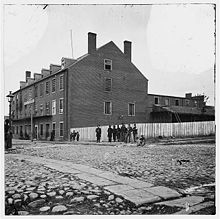Castle Thunder
Castle Thunder in Richmond , Virginia was a military prison of the Confederate States Army during the Civil War . It consisted of three buildings within a block on Cary Street: a former tobacco factory, a department store, and a factory building.
It served to accommodate civilian prisoners, including political prisoners counted, spies of the northern states and especially those who were accused of treason. A considerable number of the inmates consisted of death row inmates . Although inmates were allowed to receive or buy packages with medical contents and other items to make life easier, the prison was no less feared than the infamous Libby Prison because of the brutality of the guards .
The commanding officer was Captain George W. Alexander. He had been captured by Union forces while fighting in Maryland . However, he managed to escape and return to his own troops. He then received the post of prison commandant in Richmond.
After word of the disproportionate and exaggerated brutality of the security guards and their commanding officer had spread, the Confederate House of Representatives felt compelled to initiate an investigation into Alexander's behavior in 1863. This was accused of harshness, inhumanity, tyranny and dishonesty. The allegations against Alexander were eventually dropped, as he successfully cited the wickedness of the prisoners and their hardened character to justify them.
One of the inmates was a Northern officer, William Jackson Palmer (1836-1909). He was caught in civilian clothes in the positions of the Confederate Army of Northern Virginia in 1862 before the Battle of Antietam . He had the task information to the commander in chief of the Army of the Potomac , Major General George B. McClellan to collect. Held on by the southern troops, he said his name was WJ Peters and that he owned a mine on an inspection tour. Although not directly believed to be a spy, he was arrested for the strange circumstances and taken to Castle Thunder. He was released in February 1863 during a prisoner exchange.
Another well-known figure was Mary Edwards Walker , a doctor , the only female person to ever receive the Medal of Honor .
After Union forces captured the city of Richmond, Castle Thunder served as a prison for war crimes suspected southerners. One of the inmates at the time was Mollie Bean , a woman who had fought undetected for two years in the 47th North Carolina Infantry Regiment and was wounded twice in the process. She said she had only pretended to be a man to join the Confederate Army, but was suspected of espionage by the US troops who captured her .
The building was later demolished and there is now a parking lot on the corner of East Cary Street and North 18th Street.
literature
- Feeney, William R. George W. Alexander and Castle Thunder: A Confederate Prison and Its Commandant. Civil War History, Sep 2009, Vol. 55 Issue 3, p425-427
Individual evidence
- ↑ Castle Thunder Prison. Zombek, Angela M. "Castle Thunder Prison." Encyclopedia Virginia, June 7, 2011; accessed December 24, 2013 (prison composition).
Coordinates: 37 ° 31 '56 " N , 77 ° 25' 41" W.
